Practice Free AZ-305 Exam Online Questions
HOTSPOT
Your on-premises datacenter contains a server named Server1 that runs Microsoft SQL Server 2022. Server1 contains a 30-TB database named DB1 that stores customer data. Server1 runs a custom application named App1 that verifies the compliance of records in DB1.
App1 must run on the same server as DB1.
You have an Azure subscription.
You need to migrate DB1 to Azure. The solution must minimize administrative effort.
To which service should you migrate DB1, and what should you use to perform the migration? To answer, select the appropriate options in the answer area.

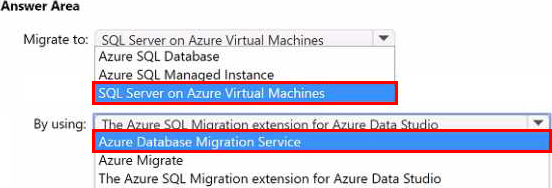
Note: This question is part of a series of questions that present the same scenario. Each question in the series contains a unique solution that might meet the stated goals. Some question sets might have more than one correct solution, while others might not have a correct solution.
After you answer a question in this section, you will NOT be able to return to it. As a result, these questions will not appear in the review screen.
Your company plans to deploy various Azure App Service instances that will use Azure SQL databases.
The App Service instances will be deployed at the same time as the Azure SQL databases.
The company has a regulatory requirement to deploy the App Service instances only to specific Azure regions. The resources for the App Service instances must reside in the same region.
You need to recommend a solution to meet the regulatory requirement.
Solution: You recommend creating resource groups based on locations and implementing resource locks on the resource groups.
Does this meet the goal?
- A . Yes
- B . No
B
Explanation:
Resource locks are not used for compliance purposes. Resource locks prevent changes from being made to resources.
Reference: https://docs.microsoft.com/en-us/azure/azure-resource-manager/management/lock-resources
You plan to move a web application named App1 from an on-premises data center to Azure.
App1 depends on a custom COM component that is installed on the host server.
You need to recommend a solution to host App1 in Azure.
The solution must meet the following requirements:
✑ App1 must be available to users if an Azure data center becomes unavailable.
✑ Costs must be minimized.
What should you include in the recommendation?
- A . In two Azure regions, deploy a load balancer and a virtual machine scale set.
- B . In two Azure regions, deploy a Traffic Manager profile and a web app.
- C . In two Azure regions, deploy a load balancer and a web app.
- D . Deploy a load balancer and a virtual machine scale set across two availability zones.
D
Explanation:
(https://docs.microsoft.com/en-us/dotnet/azure/migration/app-service#com-and-com-components)
Azure App Service does not allow the registration of COM components on the platform. If your app makes use of any COM components, these need to be rewritten in managed code and deployed with the site or application. https://docs.microsoft.com/en-us/dotnet/azure/migration/app-service
"Azure App Service with Windows Containers If your app cannot be migrated directly to App Service, consider App Service using Windows Containers, which enables usage of the GAC, COM components, MSIs, full access to .NET FX APIs, DirectX, and more."
HOTSPOT
You have an Azure subscription named Subscription1 that is linked to a hybrid Azure Active Directory (Azure AD) tenant.
You have an on-premises datacenter that does NOT have a VPN connection to Subscription1. The datacenter contains a computer named Server1 that has Microsoft SQL Server 2016 installed. Server1 is prevented from accessing the internet.
An Azure logic app named LogicApp1 requires write access to a database on Server1.
You need to recommend a solution to provide LogicApp1 with the ability to access Server1.
What should you recommend deploying on-premises and in Azure? To answer, select the appropriate options in the answer area. NOTE: Each correct selection is worth one point.
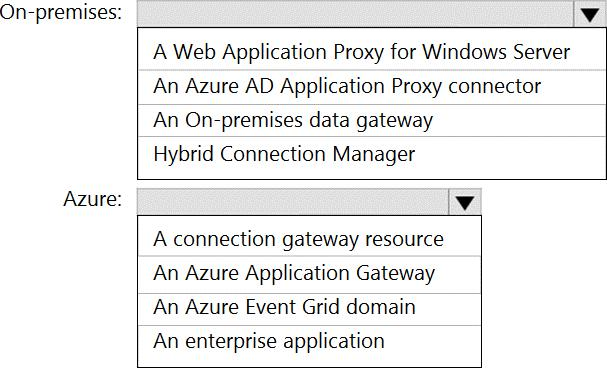
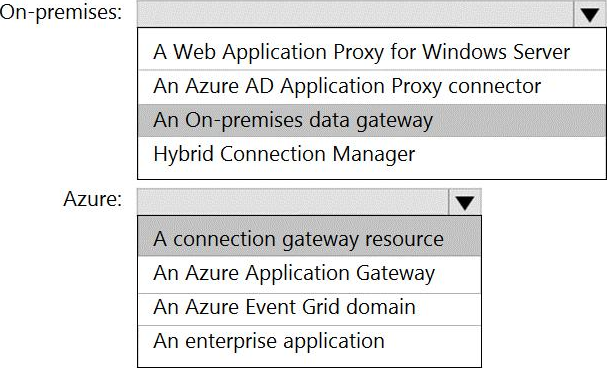
Explanation:
Box 1: An on-premises data gateway
For logic apps in global, multi-tenant Azure that connect to on-premises SQL Server, you need to have the on-premises data gateway installed on a local computer and a data gateway resource that’s already created in Azure.
Box 2: A connection gateway resource
Reference: https://docs.microsoft.com/en-us/azure/connectors/connectors-create-api-sqlazure
You need to recommend a strategy for the web tier of WebApp1. The solution must minimize.
What should you recommend?
- A . Create a runbook that resizes virtual machines automatically to a smaller size outside of business hours.
- B . Configure the Scale Up settings for a web app.
- C . Deploy a virtual machine scale set that scales out on a 75 percent CPU threshold.
- D . Configure the Scale Out settings for a web app.
You plan to deploy an Azure BareMetal Infrastructure instance that will host the data tier of a business-critical workload. The application tier of the workload will be hosted on Azure virtual machines.
You need to configure the virtual machines to minimize network latency between the application tier and the data tier.
What should you use?
- A . an availability zone
- B . ExpressRoute FastPath
- C . an availability set
- D . a proximity placement group
You are designing a microservices architecture that will support a web application.
The solution must meet the following requirements:
✑ Allow independent upgrades to each microservice
✑ Deploy the solution on-premises and to Azure
✑ Set policies for performing automatic repairs to the microservices
✑ Support low-latency and hyper-scale operations
You need to recommend a technology.
What should you recommend?
- A . Azure Service Fabric
- B . Azure Container Service
- C . Azure Container Instance
- D . Azure Virtual Machine Scale Set
A
Explanation:
https://docs.microsoft.com/en-us/azure/service-fabric/service-fabric-overview
HOTSPOT
Your company develops a web service that is deployed to an Azure virtual machine named VM1. The web service allows an API to access real-time data from VM1.
The current virtual machine deployment is shown in the Deployment exhibit. (Click the Deployment tab).
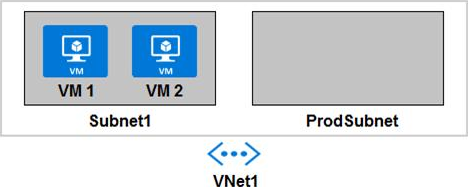
The chief technology officer (CTO) sends you the following email message: “Our developers have deployed the web service to a virtual machine named VM1. Testing has shown that the API is accessible from VM1 and VM2. Our partners must be able to connect to the API over the Internet. Partners will use this data in applications that they develop.”
You deploy an Azure API Management (APIM) service.
The relevant API Management configuration is shown in the API exhibit. (Click the API tab.)

For each of the following statements, select Yes if the statement is true. Otherwise, select No. NOTE: Each correct selection is worth one point.


Explanation:
Reference: https://docs.microsoft.com/en-us/azure/api-management/api-management-using-with-vnet
HOTSPOT
Your company has the divisions shown in the following table.

You plan to deploy a custom application to each subscription.
The application will contain the following:
✑ A resource group
✑ An Azure web app
✑ Custom role assignments
✑ An Azure Cosmos DB account
You need to use Azure Blueprints to deploy the application to each subscription.
What is the minimum number of objects required to deploy the application? To answer, select the appropriate options in the answer area. NOTE: Each correct selection is worth one point.
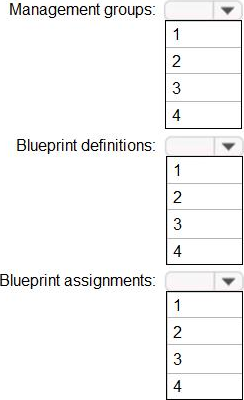
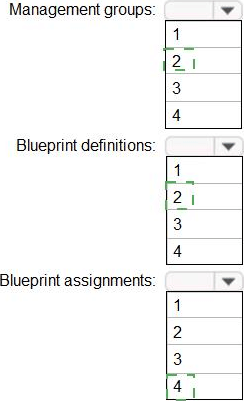
Explanation:
Box 1: 2
One management group for East, and one for West.
When creating a blueprint definition, you’ll define where the blueprint is saved. Blueprints can be saved to a management group or subscription that you have Contributor access to. If the location is a management group, the blueprint is available to assign to any child subscription of that management group.
Box 2: 2
Box 3: 4
One assignment for each subscription.
"Assigning a blueprint definition to a management group means the assignment object exists at the management group. The deployment of artifacts still targets a subscription. To perform a management group assignment, the Create Or Update REST API must be used and the request body must include a value for properties.scope to define the target subscription." https://docs.microsoft.com/en-us/azure/governance/blueprints/overview#blueprint-assignment
You plan provision a High Performance Computing (HPC) cluster in Azure that will use a third-party scheduler.
You need to recommend a solution to provision and manage the HPC cluster node.
What should you include in the recommendation?
- A . Azure Lighthouse
- B . Azure CycleCloud
- C . Azure Purview
- D . Azure Automation
B
Explanation:
You can dynamically provision Azure HPC clusters with Azure CycleCloud.
Azure CycleCloud is the simplest way to manage HPC workloads.
Note: Azure CycleCloud is an enterprise-friendly tool for orchestrating and managing High Performance Computing (HPC) environments on Azure. With CycleCloud, users can provision infrastructure for HPC systems, deploy familiar HPC schedulers, and automatically scale the infrastructure to run jobs efficiently at any scale. Through CycleCloud, users can create different types of file systems and mount them to the compute cluster nodes to support HPC workloads.
Reference: https://docs.microsoft.com/en-us/azure/cyclecloud/overview
